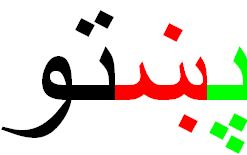Five Tips for Reading Pashto Script Posted by Sayed Naqibullah on Jan 28, 2013 in Basic, language, Pashto Alphabet
1. The unique letters: Pashto adopted the Arabic alphabet and added some extra letters to accommodate for the sounds that are unique to Pashto. In order to read the Pashto script correctly you need to be able to pronounce these letters correctly. The following are the letters that are unique to Pashto. You can listen to the correct pronunciation and example words in the accompanying video: څ ځ ښ ږ ڼ ړ ډ ټ
2. Diacritic Marks: Diacritic marks are used to show the short vowel sounds. In Pashto, the short vowel symbols are not normally writing, but if you are learning Pashto as a second language it is always a good idea to have your instructor write the diacritic marks on the letters to make reading and pronouncing easier. There are three diacritic marks you can use in Pashto: َ zabar which represents a short “a” sound and appears above a letter; ِ kasra represents a short “e” sound and appears underneath a letter: ُ Paikh represents a short “o” sound and appears above a letter. The little circles are placeholders; when these marks are used in a word the circle does not appear. Here are the examples: لړَم “larram”, مِلت “melat” مُبارزه “mobareza”.
3. Shape of letters: In Pashto, the letters have different shapes depending on where they appear in a word. Most of the letters in Pashto have three shapes: initial, medial, and final. Some of the letters may have a fourth form when they are not attached. If you know the letter, usually, you can recognize all the different shapes it takes. But it is important to know that they change and remember their identifying characteristics such as the number of dots, and the position of dots. Here is an example of how the letter “ain” ﻉ looks like in different position in a word: initial ﻋ medial ﻌ finalﻊ
4. Letters that don’t connect: Majority of letters in Pashto connect to each other in a word, however, there is a group of ten letters that only can be connected to the preceding letter in a word, they never can be connected to the letter following them in a word. For example, the in the word لرم the letter “ray”, highlighted in red, is connected only to the letter preceding it, but not to the letter following it. Also remember that letters in this group can never be connected to each other. د ډ ذ ر ړ ز ژ ږ و ا
5. The letters alef and laam: When the letter “alef” ا, and the letter “ laam” ل appear in a word they look very similar and can be mistaken for each other quite often. For instance, in the wordلپاره (read left to right) the two letters highlighted in red look very similar . As mentioned, alef is one of the letters that does not connect to the following letter, therefore, in this case we can easily recognize that the second letter is alef because it is not connected to the following letter.

Build vocabulary, practice pronunciation, and more with Transparent Language Online. Available anytime, anywhere, on any device.
About the Author: Sayed Naqibullah
Sayed Naqibullah speaks Pashto and Dari as his native languages. Since 2004 he has been teaching Dari and Pashto and working as cultrual advisor to NGO workers, foreigners who live, work, or are visiting Afghanistan. Sayed has worked as a linguist for several companies that produce language course-ware. He has worked as a guide, interpreter and translator of a number of NGOs working in Afghanistan. Sayed is also a blog writer on Afghan culture and languages. He is the author of a Dari language textbook called “Dari as a Second Language”.





Comments:
Aaron Squadrilli:
dera dera manana. Very useful tips. one thing I have noticed to help with how words link in Pashto language, is by getting a pashto keybord app.. and via trial and error.. attempting to translate various scripts. For me, this was a very handy method of navigating the written language of Pashto. Still, I have a long way to go. Regardless, thank you for the information. Regards, Aaron Squadrilli
هاند:
I’d love to hear more about the differences between ت، ر، and ړ، ټ because honestly I can’t tell the difference, other than emphasis on those letters. I do understand too they usually can signal for formal nouns, but as a non-native speaker they seem extraneous.
هاند:
I also forgot about ډ او د